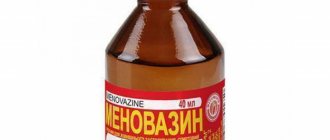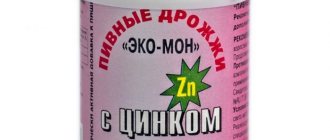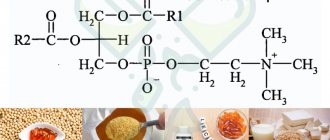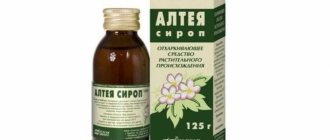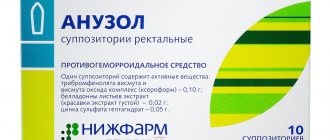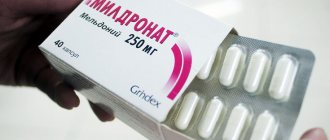Pharmacodynamics and pharmacokinetics
The drug Bromhexine is characterized by secretolytic (mucolytic) and expectorant properties, for which tablets and syrup of the drug are used for dry cough in adults and children. The secretolytic effectiveness of bromhexine is manifested due to its ability to liquefy and depolymerize mucoprotein and mucopolysaccharide fibers of bronchial secretions . Also important in the productivity of treatment with bromhexine is its stimulation of the formation of surfactant , a surface-active substance that lines the alveoli of the lungs , thereby increasing the protective function of the pulmonary system. In addition to its main effects, the drug has a weak antitussive effect.
Oral (oral) administration of bromhexine leads to its almost complete absorption (99%) from the gastrointestinal tract within 30 minutes. Due to the “ first pass ” effect through the liver, the drug has low bioavailability (about 20%). Plasma protein binding is quite high. Able to penetrate the placental and blood-brain barriers . Hepatic metabolic transformations occur through oxidation and demethylation . T1/2 due to slow reverse tissue diffusion averages 15 hours. Excretion is carried out mostly by the kidneys. Has the ability to accumulate in the body. With kidney pathologies, metabolic products is disrupted.
Composition and release form
The drug is available in the form of tablets and syrup for oral administration. The tablets are white, coated with a special soluble coating. Packed in cardboard packaging up to 100 pieces.
Syrup of uniform color and consistency. Sold in dark glass bottles of 50, 60 or 100 ml.
The active substance of the drug is bromhexine. Its content in tablets and syrup varies from 4 to 8 mg. Auxiliary components: sucrose, pure water, ethyl alcohol, polysorbate, sodium hydrogen phosphate, eucalyptus oil.
Indications for use
Indications for the use of Bromhexine are painful conditions of the bronchopulmonary system in the presence of difficult-to-clear viscous sputum ( tracheobronchitis , emphysema , bronchial asthma , pneumoconiosis , cystic fibrosis , bronchiectasis, tuberculosis , obstructive bronchitis , pneumonia ).
The drug is also used in the preoperative period for the sanitation (health improvement) of the bronchial tree ; in the postoperative period for the preventive removal of sputum accumulation in the bronchi; during diagnostic and therapeutic clinical intrabronchial manipulations .
What does Bromhexine help with?
Indications for taking Bromhexine are:
- Bronchiectasis.
- Tuberculosis.
- Bronchitis, predominantly obstructive.
- Cystic fibrosis.
- Pneumonia.
- Emphysema.
- Bronchial asthma.
In addition, the drug is prescribed before and after surgery to sanction the respiratory system and conduct diagnostic procedures.
Contraindications
Before taking Bromhexine in tablets or syrup, you should familiarize yourself with the contraindications to its use.
Absolute contraindications include:
- lactation;
- peptic ulcer of the gastrointestinal tract in the period of exacerbation;
- pregnancy in the first trimester;
- children under 2 years of age for syrup and up to 6 years for tablets;
- personal hypersensitivity ;
- sugar intolerance.
Carefully:
- / kidney pathologies ;
- diabetes;
- tendency to gastrointestinal bleeding ;
- bronchopulmonary painful conditions with the accumulation of excessive amounts of secretion ;
- pregnancy in the second and third trimester.
special instructions
The drug is used with extreme caution for bronchial asthma, especially during exacerbation.
Patients with ulcerative processes of the digestive tract and bleeding from the gastrointestinal tract should take the medication under the supervision of a physician.
It is not recommended to combine the medicine with codeine. Because it interferes with the liquefaction and coughing up of sputum.
Brombexine is best taken together with natural combined action products that contain essential oils (eucalyptus, anise, peppermint or menthol).
Side effects
- dyspeptic manifestations;
- nausea, vomiting;
- feeling dizzy ;
- exacerbation of peptic ulcer disease;
- headache;
- allergic phenomena (skin rash / itching , rhinitis , Quincke's edema , etc.);
- increased activity enzymes .
Instructions for use of Bromhexine
Bromhexine tablets, instructions for use
Bromhexine tablets are intended for oral (inside) administration. Tablets can be taken regardless of meals, with 100-200 ml of water. Adults are advised to take a single dose of 8-16 mg of the drug 3-4 times every 24 hours. From 6 to 14 years of age they take 8 mg 3 times a day. The effect of therapy can only develop on days 4-6.
Bromhexine syrup, instructions for use
The syrup of the drug is mainly intended for use in pediatrics, although it does not exclude the use of the drug by adult patients in the same dosages and frequency of administration as prescribed for tablets (8-16 mg 3-4 times a day).
Children's syrup is produced with a mass content of the active ingredient of 4 mg/5 ml and is often equipped with a measuring beaker for ease of dosing, such as Bromhexine Nycomed , a measuring cup or spoon.
Instructions for use of Bromhexine for children recommend that patients aged 2-6 years take 2.5-5 ml (2-4 mg); 6-10 years – 5-10 ml (4-8 mg); after 10 years - 10 ml (8 mg) of syrup for children three times a day.
When using Bromhexine for children, it is recommended to simultaneously use a vibration massage of the child’s chest or a postural drainage in order to further facilitate the discharge of secretions .
The course of treatment for any of the pharmacological forms of the drug can last from 4 to 28 days. During therapy, the patient should be provided with sufficient fluid intake to maintain productive secretological action.
Characteristics of the substance
Latin name of the substance : Bromhexinum
Formula : C14H20Br2N2
Chemical name : 2-Amino-3,5-dibromo-N-cyclohexyl-N-methylbenzenemethanamine. The preparations also contain it in the form of camsilate or hydrochloride.
Description : White crystalline powder, slightly soluble in water and alcohol.
Clinical and pharmacological group
- Mucolytic and expectorant drug
- Secretolytic and stimulator of motor function of the respiratory tract
Interaction
Do not prescribe in parallel with antitussive drugs (for example, codeine-containing ones ) due to difficulty in the discharge of bronchial secretions.
Combined use with NSAIDs can irritate the gastrointestinal mucosa and even lead to the formation of erosions and ulcers .
The use of Bromhexine favors the penetration of sulfonamide drugs and antibiotics ( Oxytetracycline , Erythromycin , Amoxicillin , Cephalexin ) into the bronchial secretions in the first 4-5 days of antibiotic therapy.
Analogs
Level 4 ATX code matches:
Mukolik
Abrol
Ambrosan
Bronchorus
ACC 100
ACC 200
ACC Long
ACC
Mukolwan
Lazolvan
Bromhexine 8
Bromhexine 8 Berlin-Chemie
Bronchobos
Carbocisteine
Erdomed
Pulmozyme
Pectolvan C
Halixol
Ambrobene
Acetylcysteine
If for some reason the use of Bromhexine is impossible, the doctor may recommend the following analogues:
- Ambrobene;
- Libexin;
- Acestine;
- Lazolvan;
- AmbroHexal;
- Ascoril;
- Bronchoxol;
- Ambroxol;
- ACC;
- Bronchosan;
- Acetylcysteine;
- Flavamed;
- Fluditek;
- Fluimucil , etc.
For children
The instructions for the drug prohibit taking tablets up to 6 years and taking syrup up to 2 years.
The main prescribed dosage form of Bromhexine for children from 2 to 6 years old, due to the possibility of more accurate dosing (measuring spoon or beaker) and ease of swallowing, is oral syrup for children, used in the above dosages. The mass fraction of bromhexine in tablets for children is 4 mg and is prescribed to children over 6 years of age in doses appropriate to their age category.
Overdose
Symptoms: increased adverse reactions. Nausea, vomiting, diarrhea and other gastrointestinal disorders.
Treatment: artificial vomiting, fluid intake (milk or water) in the first 1–2 hours after administration, symptomatic therapy.
In children : Since children over 2 years of age, even after taking large doses of bromhexine, only mild symptoms are expected, detoxification may not be necessary with a dose of bromhexine hydrochloride up to 80 mg (for example, 100 ml of Bromhexine). In younger children, the appropriate dose limit is 60 mg bromhexine hydrochloride (6 mg/kg body weight).
Life-threatening overdoses with bromhexine in humans are unknown. There is no evidence of chronic toxicity.
Reviews of Bromhexine
As a rule, reviews of Bromhexine from adult patients who understand exactly what the drug tablets are needed for, namely, to liquefy viscous sputum in order to remove it as quickly as possible, are positive. In most cases, the drug copes with its task perfectly and practically, with rare exceptions, does not lead to side effects. The situation is a little more complicated when the question concerns young patients and their mothers, who want to cure their child’s cough as soon as possible and, if this does not happen quickly, are ready to speak negatively about any medicine. Let us remind you once again that Bromhexine syrup for children is intended to solve the problem of softening bronchial secretions , and various bronchopulmonary diseases may require treatment with different drugs from many drug groups and often in combination. Therefore, before giving your baby any medicine, you simply need to seek qualified advice from a pediatrician and strictly follow his instructions.
Bromhexine price, where to buy
The price of the drug, depending on the manufacturer and the number of tablets or bottle volume, differs slightly, but remains within the limits available to almost every consumer.
So the price of Bromhexine in tablets 8 mg No. 50 varies from 25 to 50 rubles; the price of Bromhexine syrup 8 mg/5ml 150 ml is within 150 rubles, and syrup for children 4 mg/5 ml 100 ml can be bought for 60-80 rubles.
- Online pharmacies in RussiaRussia
- Online pharmacies in UkraineUkraine
- Online pharmacies in KazakhstanKazakhstan
ZdravCity
- Bromhexine apricot syrup 4 mg/5 ml 100 ml Pharmstandard-Leksredstva OJSC
RUB 143 order - Bromhexine syrup 4mg/5ml 100ml LLC "ROZLEX PHARM"
73 rub. order
- Bromhexine tablets 8 mg 20 pcs. JSC Pharmstandard (ICN) Leksredstva Kursk
36 RUR order
- Bromhexine tab. for children 4mg 50pcsOzon LLC
67 RUR order
- Bromhexine solution for internal use. approx. 4mg/5ml 60mlOzone LLC
145 rub. order
Pharmacy Dialogue
- Bromhexine-Akrikhin tablets 8 mg No. 20Akrikhin OJSC
80 rub. order
- Bromhexine-Akrikhin tablets 4 mg No. 50 Akrikhin OJSC
109 rub. order
- Bromhexine Nycomed bottle 0.8mg/ml 150mlTakeda
RUB 144 order
- Bromhexine (8 mg tablet No. 50) BZMP
60 rub. order
- Bromhexine (syrup 4 mg/5 ml 100 ml) Rozlex Pharm LLC
66 RUR order
show more
Pharmacy24
- Bromhexine 8 No. 25 tablets Berlin Chemi AG, Nimechchina
20 UAH. order - Bromhexine 0.008 N20 tablets PAT Monpharm, Ukraine
5 UAH order
- Bromhexine-8 20 ml drops Crevel Meuselbach GmbH, Niemecchina
60 UAH.order
- Bromhexine-Darnitsa No. 20 tablets PrAT” Pharmaceutical company “Darnitsa”, Ukraine
7 UAH order
- Bromhexine 4 60 ml oral solution Berlin Chemi AG, Nimechchina
53 UAH order
PaniPharmacy
- Bromhexine tablets Bromhexine 8 BERLIN-CHEMIE tablets 8 mg No. 25 Germany, Berlin-Chemie
27 UAH order
- Bromhexine liquid Bromhexine drops 8 mg/ml 20 ml Germany, Krewel Meuselbach
82 UAH order
- Bromhexine tablets Bromhexine tablets. 8mg No. 50 Ukraine, Darnitsa ChAO
17 UAH order
- Bromhexine liquid Bromhexine solution 4mg/5ml 60ml Germany, Berlin-Chemie
62 UAH.order
- Bromhexine tablets Bromhexine tablets. 8mg No. 20 Ukraine, Darnitsa ChAO
7 UAH order
show more
> Home > Drugs > Full list > Over-the-counter drugsTrade name: Bromhexine 4 Berlin - Hemi
International nonproprietary name: bromhexine
Chemical name: N - (2-amino-3,5 - dibromobenzyl) - N - methylcyclohexanamine hydrochloride
Dosage form: oral solution
Composition per 100 ml solution:
Active ingredient: bromhexine hydrochloride – 0.08 g;
Excipients: propylene glycol, sorbitol, apricot-scented aromatic concentrate, hydrochloric acid 0.1 M (3.5%) solution, purified water.
Description: transparent, colorless, slightly viscous liquid with a characteristic apricot odor.
Pharmacotherapeutic group: expectorant mucolytic agent
ATX code: R05CB02
Pharmacological properties
Pharmacodynamics
Bromhexine has a mucolytic (secretolytic) and expectorant (secretomotor) effect. Reduces the viscosity of sputum; activates the ciliated epithelium, increases the volume of sputum and improves its discharge. Stimulates the production of endogenous surfactant, which ensures the stability of alveolar cells during respiration. The effect appears within 2-5 days from the start of treatment.
Pharmacokinetics
Suction. After oral administration, bromhexine is quickly and almost completely absorbed from the gastrointestinal tract. The half-life of absorption is about 0.4 hours. The maximum concentration in the blood plasma after oral administration is reached after 1 hour.
Distribution. The volume of distribution is approximately 7 l/kg body weight. The degree of binding to plasma proteins is 99%. Bromhexine penetrates the blood-brain barrier and the placental barrier. Penetrates into breast milk and cerebrospinal fluid. Bromhexine does not accumulate.
Metabolism. 80% of bromhexine undergoes a “first pass” effect through the liver with the formation of biologically active metabolites. In severe liver diseases, a decrease in the clearance of bromhexine is observed.
Excretion. Bromhexine is excreted from the body mainly in the form of metabolites. The half-life to achieve the minimum effective concentration after achieving equilibrium between the processes of absorption and excretion is approximately 1 hour. The final half-life is approximately 16 hours due to the reverse distribution of small amounts of bromhexine from tissues.
It is excreted primarily by the kidneys in the form of metabolites formed in the liver. Due to the high degree of binding to plasma proteins and the high volume of distribution, as well as the slow redistribution from tissues to the blood, significant elimination of bromhexine by dialysis or forced diuresis should not be expected.
In severe renal failure, an increase in the half-life of bromhexine metabolites cannot be excluded. Nitrosation of bromhexine is possible under physiological conditions in the stomach.
Indications for use
Secretolytic therapy for acute and chronic bronchopulmonary diseases associated with impaired secretion and transport of sputum (for example, acute and chronic bronchitis, bronchiectasis, tracheobronchitis, pneumonia, emphysema, cystic fibrosis, tuberculosis, pneumoconiosis).
Contraindications
- hypersensitivity to bromhexine and other components of the drug;
- peptic ulcer of the stomach and/or duodenum (including a history);
- pregnancy (first trimester);
- breastfeeding period;
- children under 2 years of age;
- congenital fructose intolerance.
Carefully
- renal and/or liver failure;
- in case of impaired bronchial motility, accompanied by excessive accumulation of secretions;
- children aged from 2 to 6 years (used as prescribed by a doctor).
Use during pregnancy and breastfeeding
The use of the drug in the first trimester of pregnancy is contraindicated. In the second and third trimesters of pregnancy, the use of the drug is possible only if the expected benefit to the mother outweighs the possible risk to the fetus. The use of the drug during breastfeeding is contraindicated.
Directions for use and doses
Oral solution. 1 measuring spoon contains 5 ml of solution.
Unless otherwise prescribed, the following doses are recommended:
Adults and adolescents over 14 years of age: 3 times a day, 2-4 scoops (24-48 mg of bromhexine per day).
Children from 6 to 14 years of age, as well as patients weighing less than 50 kg: 3 times a day, 2 scoops (24 mg of bromhexine per day).
Children from 2 to 6 years: 3 times a day, 1 measuring spoon (12 mg of bromhexine per day) - used as prescribed by a doctor.
In case of impaired renal function and/or severe liver disease, the intervals between doses should be increased or the dose reduced. You should consult your doctor on this issue.
During therapy with Bromhexine 4 Berlin-Chemie, it is recommended to drink sufficient amounts of fluid.
Bromhexine 4 Berlin-Chemie should not be taken for more than 4-5 days without consulting your doctor. The duration of use is determined by the doctor individually and depends on the indications and course of the disease.
Side effect
Possible side effects are listed below in descending frequency of occurrence: very common (>1/10), common (>1/100, >1/10), uncommon (>1/1000, >1/100), rare (>1/100) 10000, <1/1000), very rare, including isolated reports (<1/10000), frequency not established (cannot be estimated from available data).
From the gastrointestinal tract
Uncommon: nausea, vomiting, diarrhea, abdominal pain;
From the immune system
Rarely: hypersensitivity reactions;
Frequency not established: anaphylactic reactions, including anaphylactic shock, angioedema, pruritus.
From the skin and subcutaneous tissues
Rarely: skin rash, urticaria;
Frequency not established: severe skin reactions, including erythema multiforme, Stevens-Johnson syndrome, toxic epidermal necrolysis (Lyell's syndrome), acute generalized exanthematous pustulosis (see section "Special instructions").
General violations
Uncommon: fever.
In case of all forms of allergic reactions (hypersensitivity, anaphylaxis) or in the event of any damage to the skin and/or mucous membranes, you must stop taking this drug and immediately inform your doctor.
Overdose
Life-threatening symptoms of overdose with Bromhexine 4 Berlin-Chemie are unknown.
Symptoms: A study of overdose cases has been published, according to which vomiting was observed in 4 out of 25 overdose cases. Three children experienced vomiting, as well as stunned consciousness, ataxia, diplopia, mild metabolic acidosis, and tachypnea. In children, symptoms did not occur when taking bromhexine at doses up to 40 mg, even in the absence of treatment.
There is no evidence of chronic toxicity of bromhexine in humans.
Treatment: in case of severe overdose, monitoring of blood circulation and, if necessary, symptomatic treatment are indicated. Due to the low toxicity of bromhexine, as a rule, there is no need for invasive measures aimed at reducing its absorption (forced vomiting, gastric lavage) or accelerating excretion. In addition, due to the pharmacokinetics (high volume of distribution, slow redistribution processes and high degree of protein binding), effective removal of bromhexine from the body by dialysis or forced diuresis should not be expected.
Since in children over 2 years of age, even after taking large doses of bromhexine, only mild symptoms are expected, with a dose of bromhexine hydrochloride up to 80 mg (for example, 100 ml of Bromhexine 4 Berlin-Chemie), detoxification may not be necessary. In younger children, the appropriate dose limit is 60 mg bromhexine hydrochloride (6 mg/kg body weight).
In case of overdose, it is also possible to develop side effects caused by excipients.
Interaction with other drugs
Bromhexine 4 Berlin-Chemie can be prescribed simultaneously with other drugs used in the treatment of bronchopulmonary diseases.
Bromhexine is not prescribed simultaneously with antitussives (including those containing codeine), because due to the suppression of the reflex, the evacuation of liquefied sputum is difficult, which can lead to the accumulation of secretions in the respiratory tract.
Bromhexine 4 Berlin-Chemie promotes the penetration of antibiotics (erythromycin, cephalexin, oxytetracycline, ampicillin, amoxicillin) into bronchial secretions in the first 4-5 days of antimicrobial therapy. The clinical significance of this possible interaction has not been proven.
When used simultaneously with drugs that irritate the gastrointestinal tract (for example, some non-steroidal anti-inflammatory drugs), the irritant effect of the latter on the gastric mucosa may be increased.
special instructions
In cases of impaired bronchial motility or with a significant volume of sputum secreted (for example, in the rare syndrome of primary ciliary dyskinesia), the use of Bromhexine 4 Berlin-Chemie requires caution due to the increased risk of airway obstruction.
In case of impaired renal function and severe liver disease, Bromhexine 4 Berlin-Chemie should be used with extreme caution (for example, it is recommended to reduce the dose or increase the intervals between doses). In severe renal failure, it is necessary to take into account the possibility of accumulation of metabolites formed in the liver.
Monitoring of liver function is recommended, especially during long-term treatment.
There is evidence of the occurrence in very rare cases of severe skin reactions (such as erythema multiforme, Stevens-Johnson syndrome, toxic epidermal necrolysis, acute generalized exanthematous pustulosis) while taking bromhexine.
If allergic reactions and/or signs of progressive skin rash occur (sometimes in combination with the appearance of blisters and damage to the mucous membranes), you should immediately stop using the drug and consult a doctor.
The use of Bromhexine 4 Berlin-Chemie in children over 2 years of age is possible only under the supervision of a physician.
Propylene glycol, which is part of the drug Bromhexine 4 Berlin-Chemie, can cause symptoms in children similar to those that occur after drinking alcohol.
Instructions for patients with diabetes: 5 ml of solution (1 scoop) contains 2 g of sorbitol (equivalent to 0.5 g of fructose), which corresponds to 0.17 bread units.
Sorbitol may have a slight laxative effect.
The effect of the drug on the ability to drive vehicles and machinery
When taken in recommended doses, Bromhexine 4 Berlin-Chemie does not affect the speed of psychomotor reactions.
Release form
Oral solution 4 mg/5 ml.
60 or 100 ml of solution in dark glass bottles with a screw-on plastic or aluminum stopper with a sealing gasket.
1 bottle complete with a measuring spoon along with instructions for use is placed in a cardboard box.
Storage conditions
At a temperature not higher than 25 oC.
Keep the medicine out of the reach of children!
Best before date
3 years.
3 months - after the first opening of the bottle.
Do not use after the expiration date stated on the packaging.
Vacation conditions
Available without a prescription.
Manufacturer
Berlin-Chemie AG
Glinker Weg, 125
12489 Berlin, Germany
Organization receiving complaints from consumers:
LLC "Berlin-Chemie/A. Menarini", Russia
123112, Moscow, Presnenskaya embankment, building 10, Business Center "Tower on the Embankment", Blok, tel., fax.
